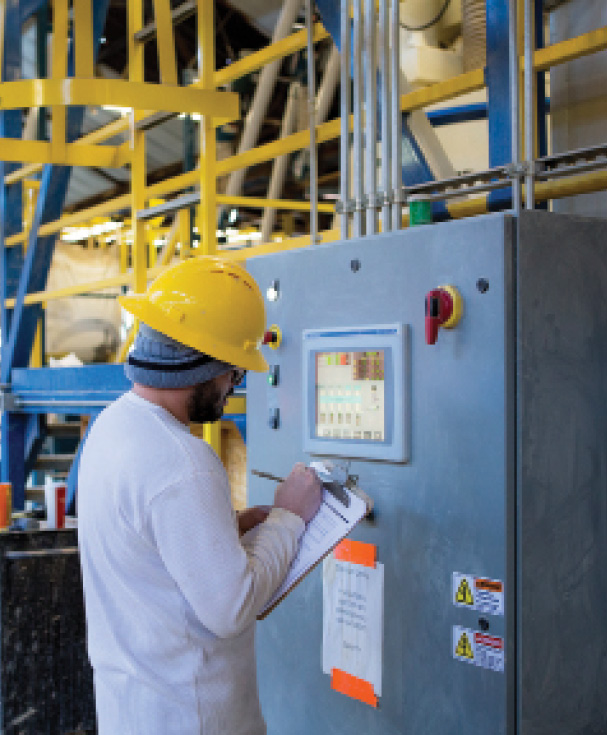Bulk Bag Weigh Batching Controls Compensate For Terra Cotta Ingredient Variations.
Edited by Mark S. Kuhar

Gladding, McBean is a leading manufacturer of terra cotta products. Founded in 1875, the company mines clay from its own reserves and combines traditional methods with modern technology to create roof tiles, floor and paving tiles, clay pipe, ornamental pieces and architectural elements for buildings.
To streamline batching and mixing of clay blends for different products, the company installed five bulk bag dischargers and five pairs of flexible screw conveyors from Flexicon to automatically deliver weighments of bulk ingredients for blending of clay compounds. The system cut dispensing and weighing time for each batch by half and reduced out-of-spec material and scrap by 95%.
Compensating for Raw Material Variations
Clay is a natural material that varies in composition, so the company must determine the ideal ratio of ingredients for various products. “We have to ensure that what we create in the lab will translate to the final material. The only way to accomplish that is to maintain precise control of production,” said Joe Parker, operations manager.
The clay is sourced from the company’s nearby mine, classified and loaded into bulk bags at the plant. Crushed, recycled ceramic material called grog is the other major component used in the manufacturing of terra cotta.
To prepare a batch, operators previously retrieved clays and grogs from bins, weighed them on a scale, and transferred them to the mixer using an open trough conveyor.
The new batching system, supplied by Flexicon Corp., integrates bulk bag dischargers, flexible screw conveyors and a central weigh hopper, all of which are actuated by programmable controls, also from the supplier. The system enables Gladding, McBean to vary bulk bag discharging, conveying, weighing, and mixing on a batch-by-batch basis according to recipes developed in the lab. A Human Machine Interface (HMI) includes options for automatic or hand-mode operation, as well as setpoints, adjustments, status, start/stop, completion and other parameters.
Once the recipe is programmed for a batch, each ingredient is conveyed by a flexible screw conveyor from a bulk bag discharger to a central weigh hopper. Load cells supporting the hopper transmit weight gain amounts to the controller, which steps-down the conveyor’s feed rate to dribble before stopping it once the precise batch weight has been gained. The system weighs up to 30 batches per day, with improved accuracy and reduced labor.

How Clays and Grogs are Batched and Blended
Five, forklift-loaded BULK-OUT BFF model bulk bag dischargers stand side by side. An operator attaches a bulk bag to the steel lifting frame by sliding the bag straps into four Z-Clip strap holders. A forklift raises the lifting frame with the 2,000 lb. (909 kg) bag of clay or grog intact, into four self-centering cradles atop the discharger frame.
With the bag in place, the operator opens a 12-in. (305-mm) diameter iris valve, pulls the bag spout through it, and closes the valve before untying the spout. The operator can then open the iris valve gradually to prevent bursts of material into the hopper, and displaced dust from escaping the enclosed system.
FLOW-FLEXER massaging devices on each discharger promote flow by raising and lowering opposite edges of the bag at timed intervals. To impart additional flow promotion, each floor hopper is equipped with a pneumatic turbine vibrator.
The clay or grog is transferred to the 40-cu.-ft. capacity central weigh hopper by flexible screw conveyors in two stages to accommodate the plant’s limited floor area and headroom. Each conveyor extends either 15 or 20 ft. (4.6 or 6.1 meters), depending on the position of the discharger and the need to route the conveyors under the roof trusses or between the truss components.
Each conveyor consists of a polymer tube with an inner flexible screw, which is driven above the discharge point, avoiding material contact with seals.
Material moves through the transition discharge adapter of the lower conveyor into the inlet of the upper conveyor. Custom-engineered masts support the top end of the first conveyor and the bottom end of the upper conveyor.
The upper conveyor gravity discharges into the weigh hopper, which is 4 ft. (1.2 meters) in diameter and suspended 19 ft. (5.7 meters) above the floor.
Most batches of clay mix weigh 1,000 lb. (454 kg) or 750 lb. (341 kg), Parker said, with a typical loading/blending cycle requiring 10 to 15 minutes. After blending with water, the batch is delivered to the appropriate process elsewhere in the plant.
“The system allows us to blend up to five different types of clays or grogs,” Parker said. For example, the dischargers might handle bulk bags of two kinds of clay and three grogs, delivering the correct amount of each for a given batch.

Weighing in on Batching Performance
“The versatility of the system makes it cost efficient,” said Egidio Modolo, plant manager. “It’s a simple, straightforward process, and an efficient way to measure and transfer clay to the blender.”
He notes that no maintenance was required in the six months since installation, and that throughout discharging, conveying and mixing the enclosed system prevents dusting.
“We can make a small or large batch, and alter the recipe and raw materials,” said Parker, adding, “currently we have two different clays and three different grogs. We can change that any time.”
“It gives us the ability to be accurate in spite of clay’s unpredictability,” Parker said. “Now we have a tool for our team in the lab to create a mix that will allow us to be very precise with our final product specifications.”
Microscopically, clay is very abrasive, Parker said. “It will destroy just about any equipment you use, over time. One of the reasons we chose this system was for simplicity of maintenance due to few moving parts, which should minimize downtime.”

Having the system in place, Parker said, “opens-up possibilities for other types of products and materials that need the same type of batching accuracy.”
Information of this article courtesy of Flexicon Corp., www.flexicon.com.
